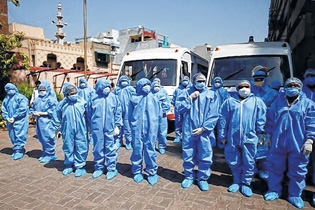COVID-19 pandemic India witnesses sharpest rise in weekly cases since May 2020
|

NEW DELHI, Mar 27
While India this week has seen the sharpest rise in weekly covid-19 cases and fatalities since May 2020, at 7.7% and 5.1%, respectively, almost 90% of the deaths continue to be in the category of those aged above 45 years.
Amidst resurgence of covid-19 cases in the country, Union Health Secretary Rajesh Bhushan on Saturday chaired a high-level review meeting with Additional Chief Secretaries, Principal Secretaries and Secretaries (Health and Family Welfare) of 12 States and municipal commissioners and district collectors of 46 districts that are the most affected by rising cases and rising morta- lity because of covid-19.
These States are Maha-rashtra, Gujarat, Haryana, Tamil Nadu, Chhattisgarh, Madhya Pradesh, West Bengal, Delhi, Jammu & Kash- mir, Karnataka, Punjab and Bihar. Dr VK Paul, Member (Health), NITI Aayog was also present during the review meeting.
The focus was on 46 districts that have contributed 71% of the cases and 69% of the deaths this month. Of total 36 districts in Maha-rashtra, 25 are most affected that account for 59.8% of the cases reported in the country during the past one week.
A granular analysis of affected districts in these States and Union territories along with some key statistics was presented.
Findings of the studies that were highlighted depicted that while 90% people are aware of the risk posed by covid, only 44% actually wear face masks. One infected person could spread covid-19 to an average of 406 other individuals in a 30-day window without restrictions, which could be reduced to just 15 by decreasing physical exposure to 50% and to a further 2.5 (average) by decreasing physical exposure to 75%.
It was also highlighted that the concept of ‘second wave’ was more a reflection of the laxity among everyone regarding covid-19 appropriate behaviour, and covid containment and management strategy at the ground level. Hence, stringent action, including effective containment and contact tracing for at least 14 successive days in 46 districts, was strongly recommended for breaking the chain of transmission, and to avoid frittering away the gains of collaborative efforts from last year.
A five-fold strategy was laid out for adoption by the states and UTs for effective containment and management of the pandemic.
The states were strongly advised to undertake a significant increase of testing in all districts in line with their positivity rate, with increased share of RT-PCR tests, to a ratio of more than 70% of the total. Rapid Antigen Test (RAT) should be mostly deployed as a screening tool in flushing out cluster cases from densely populated areas.
The Centre advised states that testing which led to detection of positive cases should be followed with prompt tracing of those who came in close contact with the infected and their swift isolation. It was advised that an average of 30 close contacts are to be traced, tested and isolated in the first 72 hours.
The health secretary highlighted the need for effective and strict means to be employed for effective containment, with focus on a micro-containment zone approach.
The Centre has laid emphasis on strengthening public and private hospital infrastructure, and re-energising healthcare workers to remove complacency and fatigue. A targeted approach towards reducing mortality rate and number of deaths must be implemented. In this regard, states must strictly follow the Standard National Treatment Protocol for effective clinical management of severe cases in ICUs. In this regard, it was pointed out that Punjab and Chhattisgarh despite being smaller in population size than Karnataka and Kerala, are reporting higher fatalities.
The Union health ministry said that renewed attention must be paid to ensuring of ‘covid appropriate behaviour’ in crowded places like markets, inter-state bus stands, schools, colleges, railway stations, etc. Covid-appropriate behaviour (CAB) should be promoted through sensitization and public awareness campaigns with active participation of local community leaders, religious heads of the community and other influencers.
States have also been advised to enforce CAB through penal measures like heavy fines, which will send an exemplary message to the people. It has been advosed to observe muted celebrations for Holi, Shab-e-barat and Easter with emphasis on keeping the festivities within the confines of the house. States were informed that 70% of the cases can be controlled by adherence to CAB alone.
The Centre further said that there should be a targeted approach to vaccination in districts reporting large numbers.
States were asked to focus on universalization of vaccination in the specified priority population age groups as an aid to containment strategy in districts where maximum cases are being reported. It was reiterated that there is no shortage of vaccines. States to optimally utilise all vaccination capacities within the public and private sectors in all districts, and make full use of the available vaccine stocks without keeping a buffer stock in anticipation of a shortage. The four government medical stores depots in Chennai, Mumbai, Kolkata and Karnal have the requisite buffer stocks and all requirements of states, based on their daily consumption and available stocks, are being met.
States were also asked to make advance planning of logistics and infrastructure management for 1-1.5 months as any unchecked spread of infection among the community may overwhelm the local administration. Re-appropriation of unused vaccine stocks in a district to focus on the high burden districts was also suggested. Courtesy Livemint